Exergoeconomic and Environmental Modeling of Integrated Polygeneration Power Plant with Biomass-Based Syngas Supplemental Firing
Abstract
1. Introduction
2. Material and Methods
2.1. System Description
2.2. Thermodynamic Modeling
2.2.1. ORC—Power Cooling System
2.2.2. Gas Turbine Plant (GT)
2.2.3. Kalina Cycle (KC)
2.2.4. Vapor Absorption System (VAB)
2.2.5. Steam Turbine Cycle (STC)
2.2.6. Gasifier Model
2.2.7. The Integrated Multi-Generation Plant (IMP)
2.3. Environmental Modeling
2.4. Sustainability Modeling
2.5. Economic Analysis
3. Results and Discussion
3.1. Thermodynamic Performance of the IMP
3.1.1. Validation and Comparison of Results
3.1.2. Parametric Analysis
3.2. Economic Evaluation
4. Optimum Parameters
5. Conclusions
- The overall power output for the subsystem was calculated at 148.73 MW for GT, 35.91 MW for ST, 42.82 kW for ORC, and 36.27 kW for the Kalina power-cooling cycle. The total power output generated by the IMP was 183 MW, which was about 1.2 times greater than the GT plant, stood alone.
- The energy and exergy efficiencies for the IMP were obtained at 61.5 and 44.22%, respectively, while the environmental parameters such as harmful emission factor, specific CO2 emission, NOx and CO values, existed at , 3.0 × 10−7, and 0.222 , in that order.
- The novel sustainability indicators applied to this study—exergetic utility exponent (EUE) and exergo-thermal index (ETI) for the IMP were calculated at 0.7335 and 0.675. These values were found to be improved, as compared to the stand-alone GT plant, which connotes good conversion efficiency.
- The cost of CO emissions was found negligible at an adiabatic flame temperature of 1200 and 2295 K, while for the same temperature range NOx and CO2 emission cost were maximum, approximated at 588.2 and 338.9$ per annum, respectively.
- Life cycle cost of $1.58 million was achieved, with a BEP (or payback period) of four years. The UCOE of 0.0166 $/kWh was obtained with exergoeconomic factor of 50.37% for the IMP. Additionally, 125.83 $/hr cost and 45.32% exergy efficiency were achieved at the optimum operating condition.
- The present study will support policymakers and decision-makers to drive sustainable energy access to meet both the Paris Agreement and Sustainable Development Goals agenda in the context of Nigeria’s energy landscape and the global south.
- The proposed system is very important to drive the current energy transition crisis caused by the COVID-19 pandemic shock in the energy sector.
Author Contributions
Funding
Conflicts of Interest
Nomenclature
| CC | combustion chamber |
| calorific value (MJ/kg) | |
| specific heat at constant volume and temperature, t (kJ/kg·K) | |
| specific heat capacity (kJ/kg·K) | |
| exergy destruction (kW) | |
| exergy flow rate (kW) | |
| h | specific enthalpy, kJ/kg |
| enthalpy of formation (kJ/kmol) | |
| mass flow rate (kg/s) | |
| number of moles | |
| P | pressure (kPa) |
| heat transfer rate (kW) | |
| T | temperature, K |
| work transfer rate (kW) |
Abbreviations
| GFS | Gasifier |
| GT | Gas turbine |
| HRSG | Heat regenerating steam generator |
| IMP | Integrated multi-generation plant |
| INTC | Intercooler |
| KC | Kalina cycle |
| KVP | Kalina evaporator |
| KPUMP | Kalina pump |
| KTUB | Kalina turbine |
| KVG | Kalina vapor generator |
| LPT, HPT | Low power turbine, high power turbine |
| OGPP | Odukpani gas power plant |
| ORC | organic Rankine cycle |
| ORCVG | ORC vapor generator |
| ORCT | ORC turbine |
| ORCEV | ORC evaporator |
| REH | reheater |
| VAB | vapor absorption |
| VABAB | VAB absorber |
| VABC | VAB condenser |
| VABD | VAB desorber |
Subscripts
| exhaust | |
| environment | |
| inlet and exit | |
| plant component | |
| refrigerant |
Appendix A
| State | T (°C) | P (bar) | h (kJ·kg−1) | s (kJ·kg·K−1) | m (kgs−1) | ||
|---|---|---|---|---|---|---|---|
| 1 | 25.0 | 1.013 | 299.4 | 5.695 | 200.00 | 0.00 | 0.000 |
| 2 | 170.1 | 3.203 | 451.6 | 5.765 | 200.00 | 131.40 | 26,280.0 |
| 3 | 120.0 | 3.203 | 397.9 | 5.643 | 200.00 | 113.90 | 22,774.0 |
| 4 | 311.3 | 10.13 | 611.9 | 5.72 | 200.00 | 305.20 | 61,034.0 |
| 5 | 583.0 | 10.13 | 951.1 | 6.131 | 200.00 | 521.80 | 104,359.0 |
| 6 | 25.0 | 10.13 | 43,852.0 | - | 3.131 | 49,349.00 | 15,4511 |
| 7 | 1077.0 | 10.13 | 1612.0 | 6.656 | 203.1 | 1027.00 | 20,8504 |
| 8 | 815.0 | 3.203 | 1259.0 | 6.734 | 203.1 | 649.90 | 131,993 |
| 9 | 627.0 | 3.203 | 2832.0 | - | 21.49 | 2064.00 | 44,347 |
| 10 | 927.0 | 3.203 | 1409.0 | 6.848 | 224.6 | 766.40 | 172,140 |
| 11 | 673.5 | 1.013 | 1070.0 | 6.905 | 224.6 | 410.10 | 92,106 |
| 12 | 401.9 | 1.013 | 721.2 | 6.533 | 224.6 | 172.10 | 38,653 |
| 24 | 20.0 | 1.013 | 83.3 | 0.294 | 42.84 | 0.00 | 0.000 |
| 25 | 80.0 | 1.013 | 334.3 | 1.073 | 42.84 | 18.77 | 803.9 |
| State | T (°C) | P (bar) | h ((kJ·kg−1) | s (kJ·kg·K−1) | m (kgs−1) | ||
|---|---|---|---|---|---|---|---|
| 14 | 350.00 | 25.00 | 3125.0 | 6.839 | 19.22 | 1091.00 | 20,978 |
| 15 | 41.60 | 0.08 | 2139.0 | 6.839 | 14.59 | 105.60 | 1540 |
| 16 | 41.60 | 0.08 | 173.7 | 0.592 | 14.59 | 1.602 | 23.38 |
| 17 | 41.60 | 1.50 | 173.9 | 0.592 | 14.59 | 1.75 | 25.47 |
| 18 | 111.50 | 1.50 | 2546.0 | 6.839 | 3.176 | 511.60 | 1625 |
| 19 | 111.50 | 1.50 | 467.1 | 1.433 | 17.76 | 44.22 | 785.4 |
| 20 | 111.50 | 5.00 | 467.4 | 1.433 | 17.76 | 44.59 | 792.0 |
| 21 | 155.30 | 5.00 | 2756.0 | 6.839 | 1.451 | 722.30 | 1048 |
| 22 | 152.00 | 5.00 | 640.3 | 1.861 | 19.22 | 90.06 | 1731 |
| 23 | 152.10 | 10.00 | 640.8 | 1.861 | 19.22 | 90.63 | 1742 |
| 68 | 165.00 | 10.00 | 697.2 | 1.988 | 19.72 | 106.40 | 2098 |
| 69 | 165.00 | 10.00 | 697.2 | 1.988 | 0.50 | 4196.00 | 2098 |
| 70 | 165.00 | 10.00 | 697.2 | 1.988 | 19.22 | 109.20 | 2098 |
| 71 | 165.20 | 25.00 | 698.8 | 1.991 | 19.22 | 109.70 | 2108 |
| 72 | 209.1 | 25 | 893.2 | 2.414 | 19.22 | 178.10 | 3424 |
| State | T (°C) | P (bar) | h (kJ·kg−1) | s (kJ·kg·K−1) | m (kgs−1) | ||
|---|---|---|---|---|---|---|---|
| 13 | 201.10 | 1.013 | 485.8 | - | 224.600 | 46.45 | 10,433 |
| 39 | 180.00 | 20.00 | 2164.0 | 5.901 | 0.193 | 625.6 | 121.00 |
| 40 | 180.00 | 20.00 | 694.1 | 2.205 | 0.305 | 135.1 | 41.22 |
| 41 | 136.90 | 7.00 | 1971.0 | 5.901 | 0.193 | 432.6 | 83.67 |
| 42 | 136.90 | 7.00 | 2080.0 | 6.209 | 0.181 | 455.8 | 82.31 |
| 43 | 42.90 | 7.00 | −42.60 | 0.480 | 0.181 | 40.75 | 7.36 |
| 44 | −5.50 | 0.80 | −42.60 | 0.5609 | 0.181 | 16.66 | 3.01 |
| 45 | 15.00 | 0.80 | 332.40 | 1.909 | 0.181 | −10.18 | −1.84 |
| 46 | 136.90 | 7.00 | 509.50 | 1.753 | 0.013 | 72.78 | 0.95 |
| 47 | 77.60 | 0.80 | 509.50 | 1.821 | 0.013 | 52.57 | 0.68 |
| 48 | 79.80 | 0.80 | 694.10 | 2.390 | 0.305 | 79.84 | 24.36 |
| 49 | 79.70 | 0.80 | 686.70 | 2.367 | 0.318 | 78.74 | 25.04 |
| 56 | 50.00 | 20.00 | 35.55 | 0.6514 | 0.499 | 6.364 | 3.17 |
| 57 | 150.00 | 1.013 | 437.30 | 6.048 | 12.630 | 32.59 | 411.60 |
| 82 | 20.00 | 1.013 | 83.30 | 0.294 | 4.581 | 0.00 | 0.00 |
| 83 | 40.00 | 1.013 | 167.00 | 0.5702 | 4.581 | 1.351 | 6.19 |
| State | T (°C) | P (bar) | h (kJ·kg−1) | s (kJ·kg·K−1) | m (kgs−1) | ||
|---|---|---|---|---|---|---|---|
| 50 | 60.0 | 0.800 | 176.8 | 0.8905 | 0.3180 | 8.989 | 2.858 |
| 51 | 43.3 | 0.800 | 213.8 | 1.2360 | 0.4986 | 10.310 | 5.142 |
| 52 | 38.0 | 0.800 | 123.0 | 0.9479 | 0.4986 | 5.441 | 2.713 |
| 53 | 25.0 | 0.800 | −73.38 | 0.3073 | 0.4986 | −0.024 | −0.012 |
| 54 | 25.1 | 20.000 | −71.24 | 0.3073 | 0.4986 | 2.110 | 1.052 |
| 55 | 40.0 | 20.000 | −7.271 | 0.5168 | 0.4986 | 3.674 | 1.832 |
| 58 | 74.7 | 0.074 | 2639.0 | 8.4510 | 0.4986 | 14.020 | 6.988 |
| 59 | 41.0 | 0.074 | 171.1 | 0.5836 | 0.0560 | 1.463 | 0.082 |
| 60 | 1.7 | 0.007 | 171.1 | 0.6229 | 0.0560 | −10.230 | −0.573 |
| 61 | 1.7 | 0.007 | 2503.0 | 9.1140 | 0.0560 | −208.500 | −11.670 |
| 62 | 34.6 | 0.007 | 92.0 | 0.1987 | 0.4164 | 0.271 | 0.113 |
| 63 | 34.6 | 0.074 | 92.0 | 0.1987 | 0.4164 | 0.275 | 0.114 |
| 64 | 67.0 | 0.074 | 156.3 | 0.3978 | 0.4164 | 5.259 | 2.190 |
| 65 | 74.7 | 0.074 | 220.6 | 0.3917 | 0.3605 | 2.915 | 1.051 |
| 66 | 45.0 | 0.074 | 169.3 | 0.2361 | 0.3605 | −1.975 | −0.712 |
| 67 | 35.0 | 0.007 | 169.3 | 0.1817 | 0.3605 | 14.220 | 5.128 |
| 86 | 20.0 | 1.013 | 83.3 | 0.2940 | 1.1700 | 0.000 | 0.000 |
| 87 | 32.0 | 1.013 | 167.0 | 0.5702 | 1.1700 | 1.350 | 1.580 |
| 88 | 20.0 | 1.013 | 83.3 | 0.294 | 1.6510 | 0.000 | 0.000 |
| 89 | 40.0 | 1.013 | 167.0 | 0.5702 | 1.6510 | 1.351 | 2.230 |
| 90 | 25.0 | 1.013 | 299.4 | 5.6950 | 5.8400 | 3.009 × 10−36 | 0.000 |
| 91 | 3.0 | 1.013 | 277.0 | 5.618 | 5.8400 | 0.599 | 3.496 |
| 92 | 20.0 | 1.013 | 83.3 | 0.2940 | 2.5950 | 0.000 | 0.000 |
| 93 | 35.0 | 1.013 | 146.0 | 0.5029 | 2.5950 | 0.509 | 1.321 |
| State | T (°C) | P (bar) | h ((kJ·kg−1) | s (kJ·kg·K−1) | m (kgs−1) | ||
|---|---|---|---|---|---|---|---|
| 26 | 180.0 | 10.00 | 1147.0 | 2.986 | 0.500 | 261.20 | 130.60 |
| 27 | 50.0 | 10.00 | 209.6 | 0.701 | 0.500 | 4.88 | 2.44 |
| 28 | 90.0 | 16.70 | 436.6 | 1.727 | 2.722 | 59.66 | 162.40 |
| 29 | 80.9 | 12.90 | 431.2 | 1.727 | 0.463 | 54.26 | 25.11 |
| 30 | 45.0 | 12.90 | 263.9 | 1.214 | 0.463 | 39.82 | 18.43 |
| 31 | −2.0 | 6.87 | 263.9 | 1.236 | 0.463 | 33.17 | 15.35 |
| 32 | −2.0 | 6.87 | 362 | 1.598 | 0.463 | 23.40 | 10.83 |
| 33 | 61.0 | 6.87 | 417.7 | 1.727 | 2.259 | 40.73 | 92.01 |
| 34 | 27.3 | 6.87 | 382.2 | 1.615 | 2.259 | 38.62 | 87.25 |
| 35 | 25.0 | 6.87 | 234.1 | 1.118 | 2.722 | 12.81 | 34.87 |
| 35′ | 25.6 | 16.70 | 378.8 | 1.603 | 2.722 | 38.61 | 105.10 |
| 36 | 25.6 | 16.70 | 235.0 | 1.121 | 2.722 | 38.43 | 104.60 |
| 37 | 45.0 | 16.70 | 264.5 | 1.214 | 2.722 | 40.34 | 109.80 |
| 75 | 25.0 | 1.013 | 299.4 | 5.695 | 1.942 | 0.00 | 0.00 |
| 76 | 2.0 | 1.013 | 276.0 | 5.614 | 1.942 | 0.67 | 1.30 |
| 77 | 20.0 | 1.013 | 83.3 | 0.294 | 0.925 | 0.00 | 0.00 |
| 78 | 40.0 | 1.013 | 167.0 | 0.570 | 0.925 | 1.35 | 1.25 |
| 79 | 20.0 | 1.013 | 83.3 | 0.294 | 3.766 | 0.00 | 0.00 |
| 80 | 45.0 | 1.013 | 187.9 | 0.637 | 3.766 | 2.51 | 9.45 |
References
- Flores, W.; Bustamante, B.; Pino, H.N.; Al-Sumaiti, A.S.; Rivera-Rodríguez, S.R. A National Strategy Proposal for Improved Cooking Stove Adoption in Honduras: Energy Consumption and Cost-Benefit Analysis. Energies 2020, 13, 921. [Google Scholar] [CrossRef]
- Steffen, B.; Egli, F.; Pahle, M.; Schmidt, T.S. Navigating the Clean Energy Transition in the COVID-19 Crisis. Joule 2020, 4, 1137–1141. [Google Scholar] [CrossRef]
- Carvalho, M.; Bandeira de Mello Delgado, D.; de Lima, K.M.; de Camargo Cancela, M.; dos Siqueira, C.A.; de Souza, D.L.B. Effects of the COVID-19 pandemic on the Brazilian electricity consumption patters. Int. J. Energy Res. 2020, e5877. [Google Scholar]
- Kanda, W.; Kivimaa, P. What opportunities could the COVID-19 outbreak offer for sustainability transitions research on electricity and mobility? Energy Res. Soc. Sci. 2020, 68, 101666. [Google Scholar] [CrossRef]
- Marques, A.D.S.; Carvalho, M.; Lourenço, A.B.; Dos Santos, C.A.C. Energy, exergy, and exergoeconomic evaluations of a micro-trigeneration system. J. Braz. Soc. Mech. Sci. Eng. 2020, 42, 1–16. [Google Scholar] [CrossRef]
- Quadrelli, R.; Peterson, S. The energy–climate challenge: Recent trends in CO2 emissions from fuel combustion. Energy Policy 2007, 35, 5938–5952. [Google Scholar] [CrossRef]
- Newman, P. COVID, CITIES and CLIMATE: Historical Precedents and Potential Transitions for the New Economy. Urban Sci. 2020, 4, 32. [Google Scholar] [CrossRef]
- Rezk, H.; Alghassab, M.; Ziedan, H.A. An Optimal Sizing of Stand-Alone Hybrid PV-Fuel Cell-Battery to Desalinate Seawater at Saudi NEOM City. Processes 2020, 8, 382. [Google Scholar] [CrossRef]
- Alghassab, M. Performance Enhancement of Stand-Alone Photovoltaic Systems with household loads. In Proceedings of the 2nd International Conference on Computer Applications & Information Security (ICCAIS), Riyadh, Saudi Arabia, 1–3 May 2019; pp. 1–6. [Google Scholar] [CrossRef]
- Ghaebi, H.; Parikhani, T.; Rostamzadeh, H.; Farhang, B. Thermodynamic and thermoeconomic analysis and optimization of a novel combined cooling and power (CCP) cycle by integrating of ejector refrigeration and Kalina cycles. Energy 2017, 139, 262–276. [Google Scholar] [CrossRef]
- Mondol, J.D.; Carr, C. Techno-economic assessments of advanced Combined Cycle Gas Turbine (CCGT) technology for the new electricity market in the United Arab Emirates. Sustain. Energy Technol. Assess. 2017, 19, 160–172. [Google Scholar] [CrossRef]
- Bicer, Y.; Dincer, I. Development of a new solar and geothermal based combined system for hydrogen production. Sol. Energy 2016, 127, 269–284. [Google Scholar] [CrossRef]
- Ozturk, M.; Dincer, I. Thermodynamic analysis of a solar-based multi-generation system with hydrogen production. Appl. Therm. Eng. 2013, 51, 1235–1244. [Google Scholar] [CrossRef]
- Mohan, G.; Dahal, S.; Kumar, U.; Martin, A.; Kayal, H. Development of Natural Gas Fired Combined Cycle Plant for Tri-Generation of Power, Cooling and Clean Water Using Waste Heat Recovery: Techno-Economic Analysis. Energies 2014, 7, 6358–6381. [Google Scholar] [CrossRef]
- Khalid, F.; Dincer, I.; Rosen, M.A. Energy and exergy analyses of a solar-biomass integrated cycle for multigeneration. Sol. Energy 2015, 112, 290–299. [Google Scholar] [CrossRef]
- Islam, S.; Dincer, I.; Yilbas, B.S. Energetic and exergetic performance analyses of a solar energy-based integrated system for multigeneration including thermoelectric generators. Energy 2015, 93, 1246–1258. [Google Scholar] [CrossRef]
- Al-Ali, M.; Dincer, I. Energetic and exergetic studies of a multigenerational solar–geothermal system. Appl. Therm. Eng. 2014, 71, 16–23. [Google Scholar] [CrossRef]
- Arafat, H.A.; Jijakli, K. Modeling and comparative assessment of municipal solid waste gasification for energy production. Waste Manag. 2013, 33, 1704–1713. [Google Scholar] [CrossRef]
- Owebor, K.; Oko, C.; Diemuodeke, E.; Ogorure, O. Thermo-environmental and economic analysis of an integrated municipal waste-to-energy solid oxide fuel cell, gas-, steam-, organic fluid- and absorption refrigeration cycle thermal power plants. Appl. Energy 2019, 239, 1385–1401. [Google Scholar] [CrossRef]
- Bonforte, G.; Buchgeister, J.; Manfrida, G.; Petela, K. Exergoeconomic and exergoenvironmental analysis of an integrated solar gas turbine/combined cycle power plant. Energy 2018, 156, 352–359. [Google Scholar] [CrossRef]
- Khalid, F.; Dincer, I.; Rosen, M.A. Techno-economic assessment of a renewable energy based integrated multigeneration system for green buildings. Appl. Therm. Eng. 2016, 99, 1286–1294. [Google Scholar] [CrossRef]
- Karellas, S.; Braimakis, K. Energy–exergy analysis and economic investigation of a cogeneration and trigeneration ORC–VCC hybrid system utilizing biomass fuel and solar power. Energy Convers. Manag. 2016, 107, 103–113. [Google Scholar] [CrossRef]
- Boyaghchi, F.A.; Heidarnejad, P. Thermoeconomic assessment and multi objective optimization of a solar micro CCHP based on Organic Rankine Cycle for domestic application. Energy Convers. Manag. 2015, 97, 224–234. [Google Scholar] [CrossRef]
- Parham, K.; Alimoradiyan, H.; Assadi, M. Energy, exergy and environmental analysis of a novel combined system producing power, water and hydrogen. Energy 2017, 134, 882–892. [Google Scholar] [CrossRef]
- Suleman, F.; Dincer, I.; Agelin-Chaab, M. Development of an integrated renewable energy system for multigeneration. Energy 2014, 78, 196–204. [Google Scholar] [CrossRef]
- Hassoun, A.; Dincer, I. Analysis and performance assessment of a multigenerational system powered by Organic Rankine Cycle for a net zero energy house. Appl. Therm. Eng. 2015, 76, 25–36. [Google Scholar] [CrossRef]
- Gadhamshetty, V.; Nirmalakhandan, N.; Myint, M.; Ricketts, C. Improving Air-Cooled Condenser Performance in Combined Cycle Power Plants. J. Energy Eng. 2006, 132, 81–88. [Google Scholar] [CrossRef]
- Odewale, S.A.; Sonibare, J.A.; Jimoda, L.A. Electricity sector’s contribution to greenhouse gas concentration in Nigeria. Manag. Environ. Qual. Int. J. 2017, 28, 917–929. [Google Scholar] [CrossRef]
- Bicer, Y.; Dincer, I. Development of a multigeneration system with underground coal gasification integrated to bitumen extraction applications for oil sands. Energy Convers. Manag. 2015, 106, 235–248. [Google Scholar] [CrossRef]
- Knudsen, T.; Clausen, L.R.; Haglind, F.; Modi, A. Energy and exergy analysis of the Kalina cycle for use in concentrated solar power plants with direct steam generation. Energy Procedia 2014, 57, 361–370. [Google Scholar] [CrossRef]
- Rashidi, J.; Ifaei, P.; Esfahani, I.J.; Ataei, A.; Yoo, C. Thermodynamic and economic studies of two new high efficient power-cooling cogeneration systems based on Kalina and absorption refrigeration cycles. Energy Convers. Manag. 2016, 127, 170–186. [Google Scholar] [CrossRef]
- Palacios-Bereche, R.; Gonzales, R.; Nebra, S.A. Exergy calculation of lithium bromide-water solution and its application in the exergetic evaluation of absorption refrigeration systems LiBr-H2O. Int. J. Energy Res. 2010, 36, 166–181. [Google Scholar] [CrossRef]
- Koroneos, C.; Lykidou, S. Equilibrium modelling for a downdraft biomass gasifier for cotton stalks biomass in comparison with experimental data. J. Chem. Eng. Mater. Sci. 2011, 2, 61–68. [Google Scholar]
- Gulder, O.L. Flame Temperature Estimation of Conventional and Future Jet Fuels. J. Eng. Gas Turbines Power 1986, 108, 376–380. [Google Scholar] [CrossRef]
- Oyedepo, S.O.; Fagbenle, R.O.; Adefila, S.S.; Alam, M.M. Thermoeconomic and thermoenvironmic modeling and analysis of selected gas turbine power plants in Nigeria. Energy Sci. Eng. 2015, 3, 423–442. [Google Scholar] [CrossRef]
- Ahmadi, P.; Dincer, I. Thermodynamic and exergoenvironmental analyses, and multi-objective optimization of a gas turbine power plant. Appl. Therm. Eng. 2011, 31, 2529–2540. [Google Scholar] [CrossRef]
- Lazzaretto, A.; Tsatsaronis, G. SPECO: A systematic and general methodology for calculating efficiencies and costs in thermal systems. Energy 2006, 31, 1257–1289. [Google Scholar] [CrossRef]
- Farshi, L.G.; Mahmoudi, S.; Rosen, M.A. Exergoeconomic comparison of double effect and combined ejector-double effect absorption refrigeration systems. Appl. Energy 2013, 103, 700–711. [Google Scholar] [CrossRef]
- Jing, Y.; Li, Z.; Liu, L.; Lu, S. Exergoeconomic Assessment of Solar Absorption and Absorption–Compression Hybrid Refrigeration in Building Cooling. Entropy 2018, 20, 130. [Google Scholar] [CrossRef]
- Oko, C.; Diemuodeke, E.; Omunakwe, E.; Nnamdi, E. Design and Economic Analysis of a Photovoltaic System: A Case Study. Int. J. Renew. Energy Dev. 2012, 1, 65–73. [Google Scholar] [CrossRef]
- Soltani, S.; Athari, H.; Rosen, M.A.; Mahmoudi, S.M.S.; Morosuk, T. Thermodynamic analyses of biomass gasification integrated externally fired, post-firing and dual-fuel combined cycles. Sustainability 2015, 7, 1248–1262. [Google Scholar] [CrossRef]
- Ahmadi, P.; Dincer, I.; Rosen, M.A. Development and assessment of an integrated biomass-based multi-generation energy system. Energy 2013, 56, 155–166. [Google Scholar] [CrossRef]
- Abam, F.; Ekwe, E.; Effiom, S.; Ndukwu, M. A comparative performance analysis and thermo-sustainability indicators of modified low-heat organic Rankine cycles (ORCs): An exergy-based procedure. Energy Rep. 2018, 4, 110–118. [Google Scholar] [CrossRef]
- Yilmaz, F.; Ozturk, M.; Selbas, R. Development and techno-economic assessment of a new biomass-assisted integrated plant for multigeneration. Energy Convers. Manag. 2019, 202, 112154. [Google Scholar] [CrossRef]
- Safari, F.; Dincer, I. Development and analysis of a novel biomass-based integrated system for multigeneration with hydrogen production. Int. J. Hydrogen Energy 2019, 44, 3511–3526. [Google Scholar] [CrossRef]
- Bamisile, O.; Huang, Q.; Dagbasi, M.; Alowolodu, O.; Williams, N. Development and Assessment of Renewable Energy–Integrated Multigeneration System for Rural Communities in Nigeria: Case Study. J. Energy Eng. 2020, 146, 05020001. [Google Scholar] [CrossRef]
- Yilmaz, F.; Ozturk, M.; Selbas, R. Design and thermodynamic assessment of a biomass gasification plant integrated with Brayton cycle and solid oxide steam electrolyzer for compressed hydrogen production. Int. J. Hydrogen Energy 2020. [Google Scholar] [CrossRef]
- Soltani, S.; Mahmoudi, S.; Yari, M.; Morosuk, T.; Rosen, M.; Zare, V. A comparative exergoeconomic analysis of two biomass and co-firing combined power plants. Energy Convers. Manag. 2013, 76, 83–91. [Google Scholar] [CrossRef]
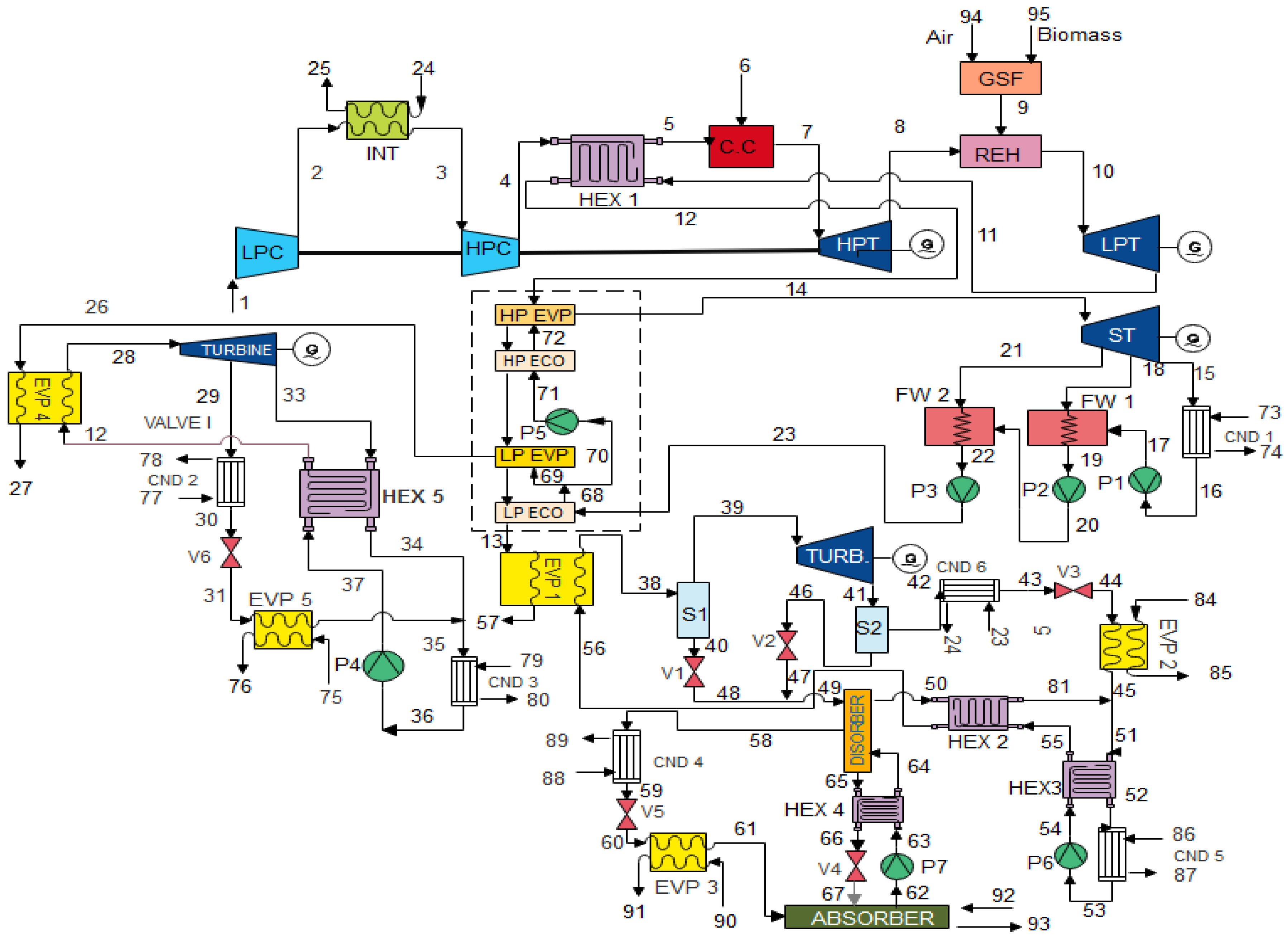
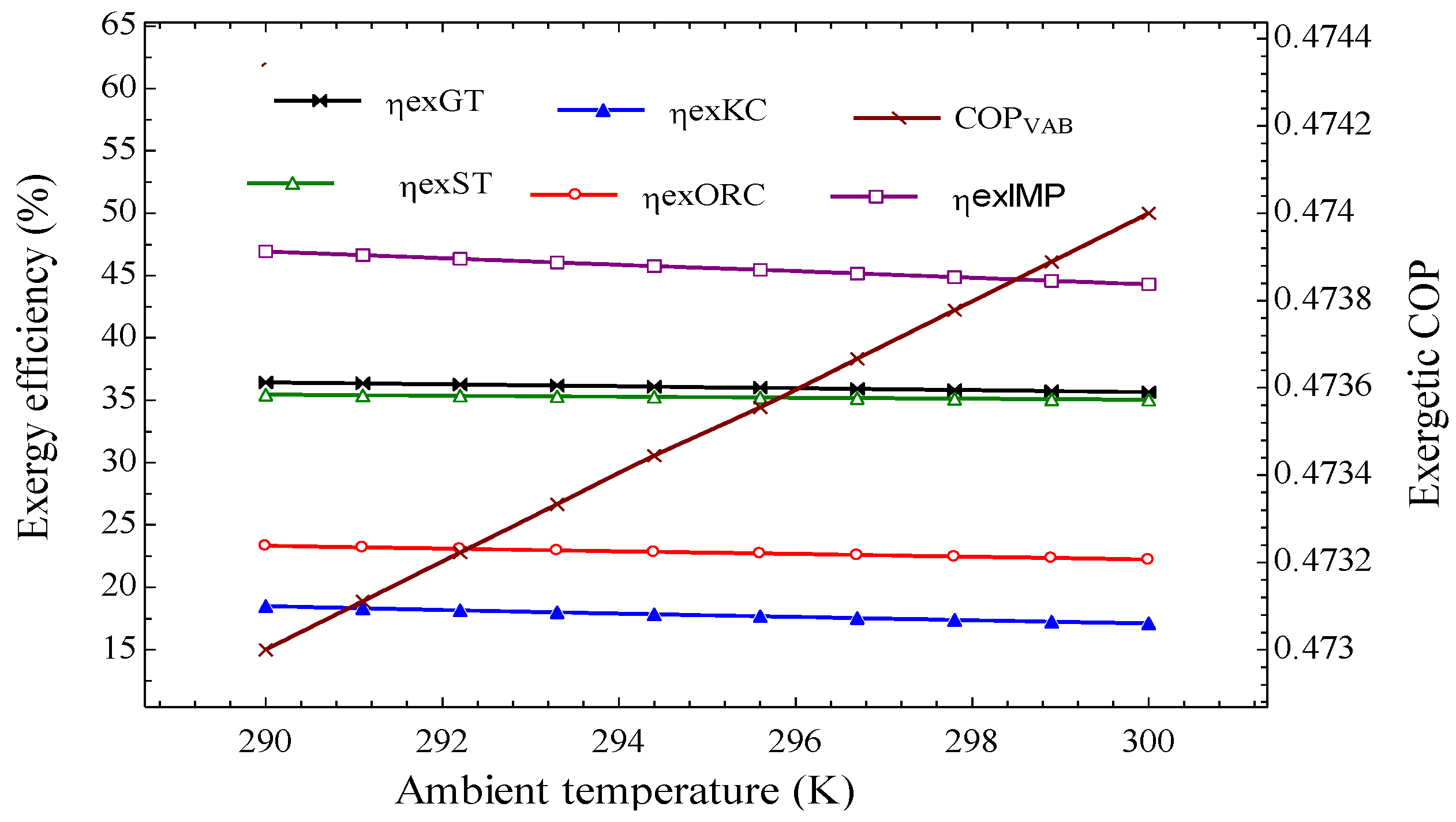
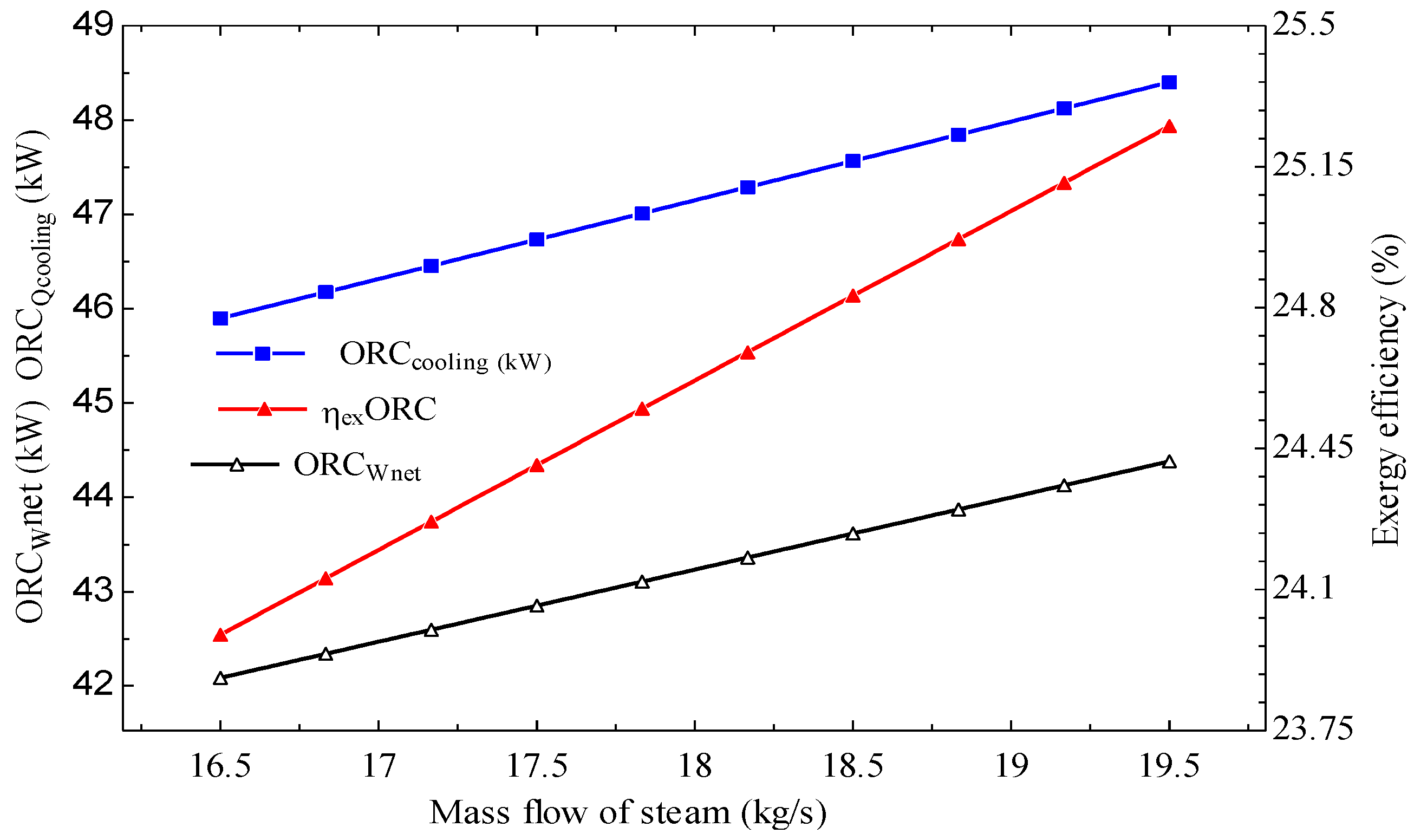
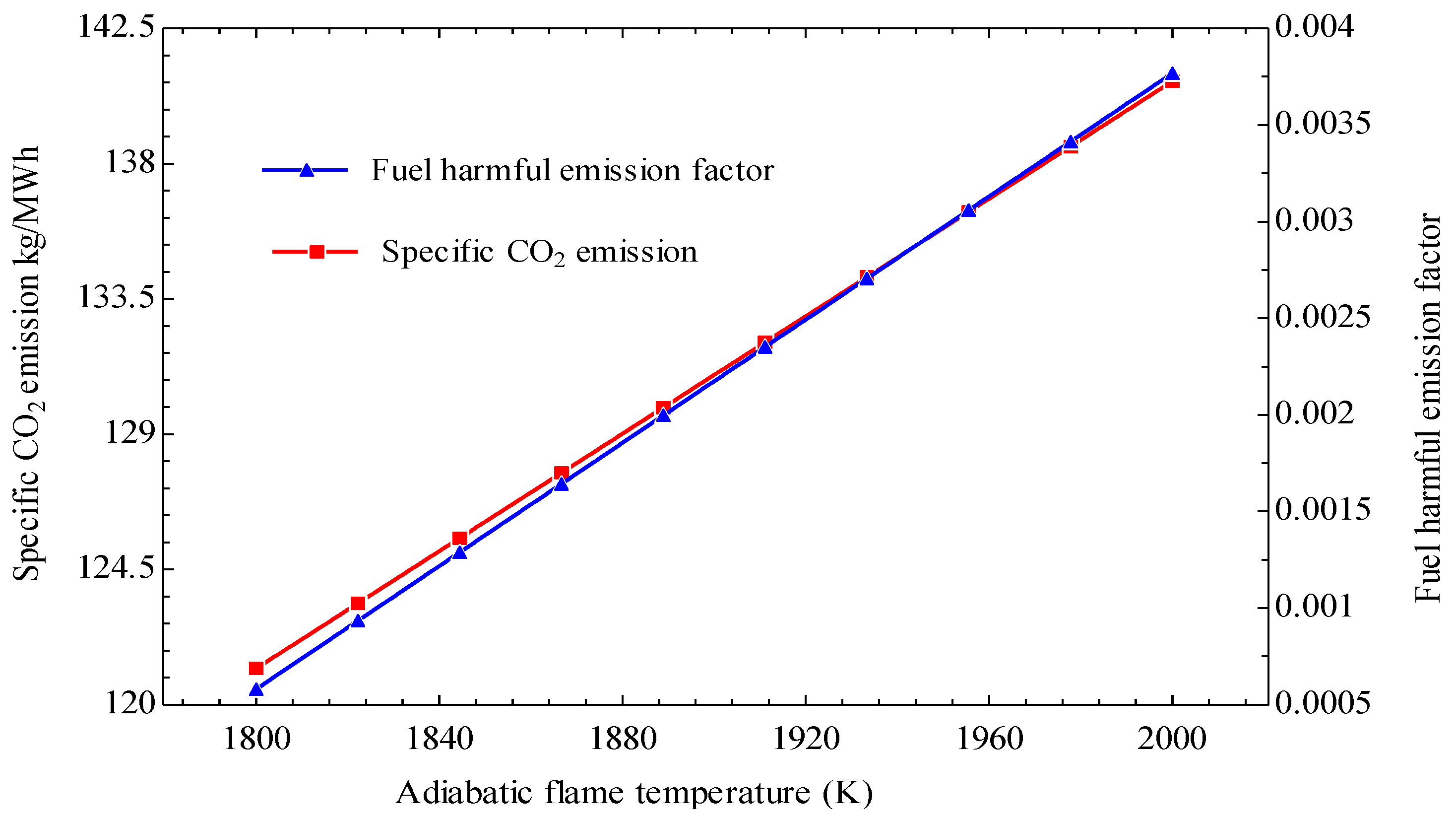
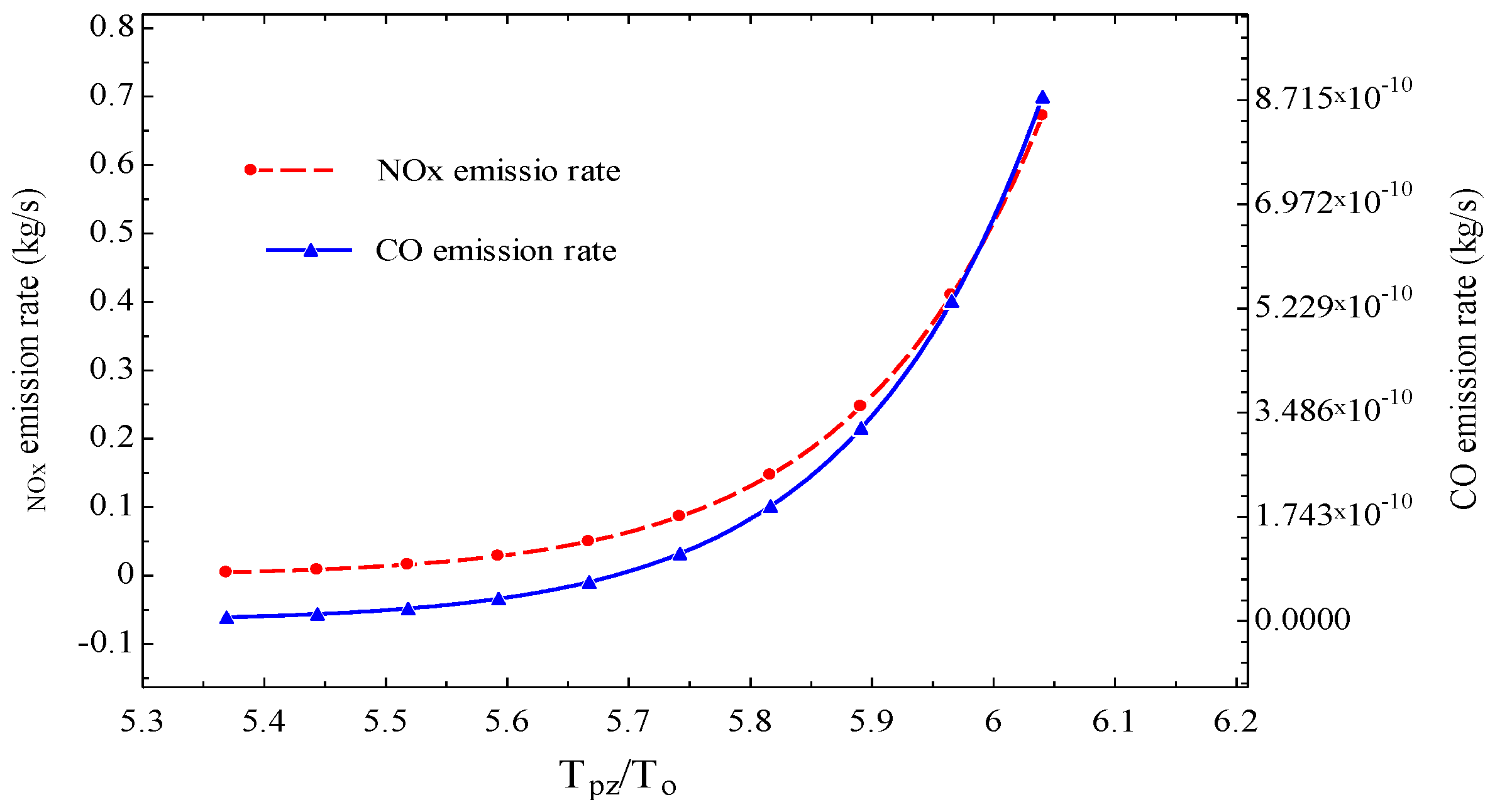
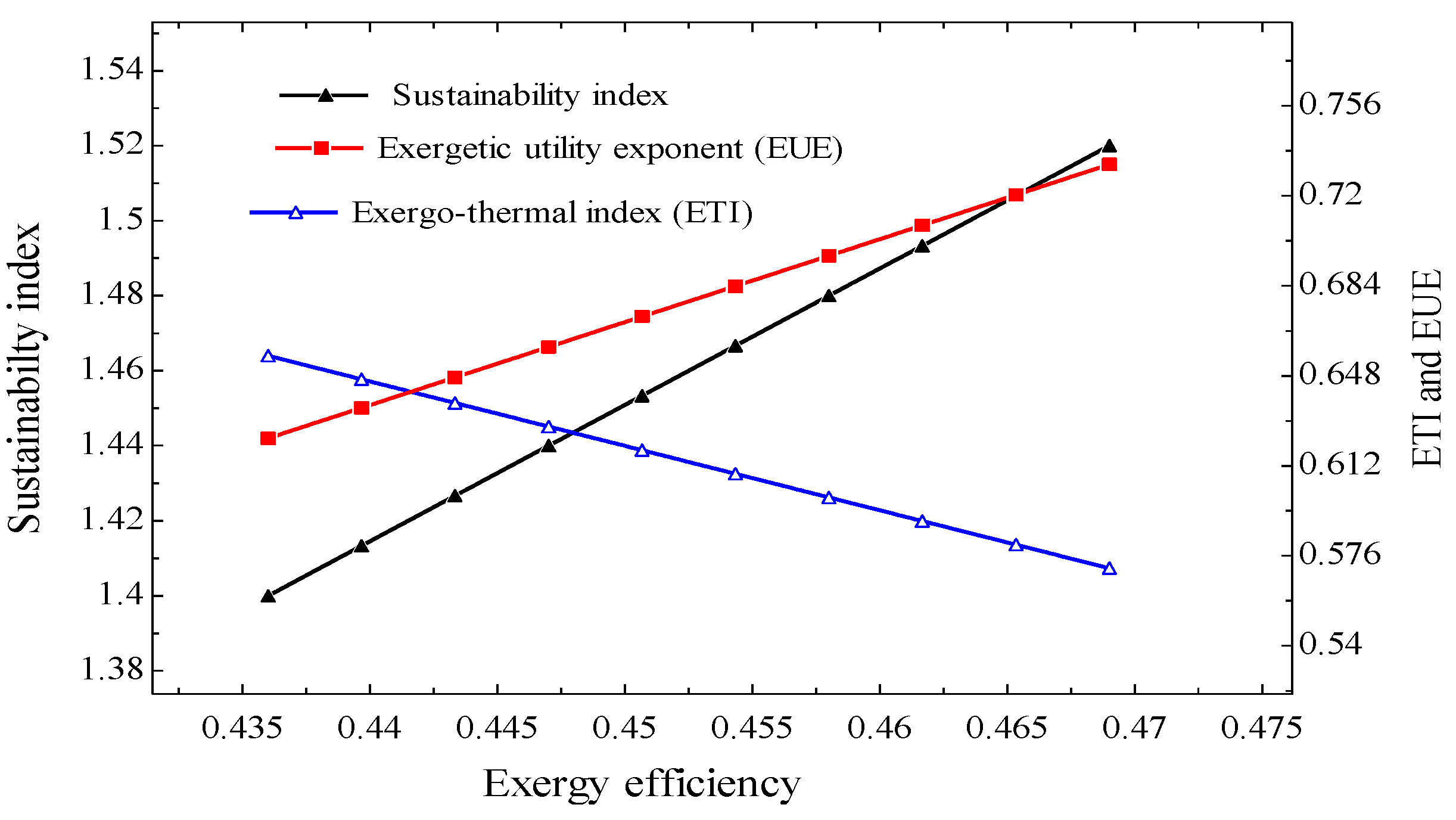
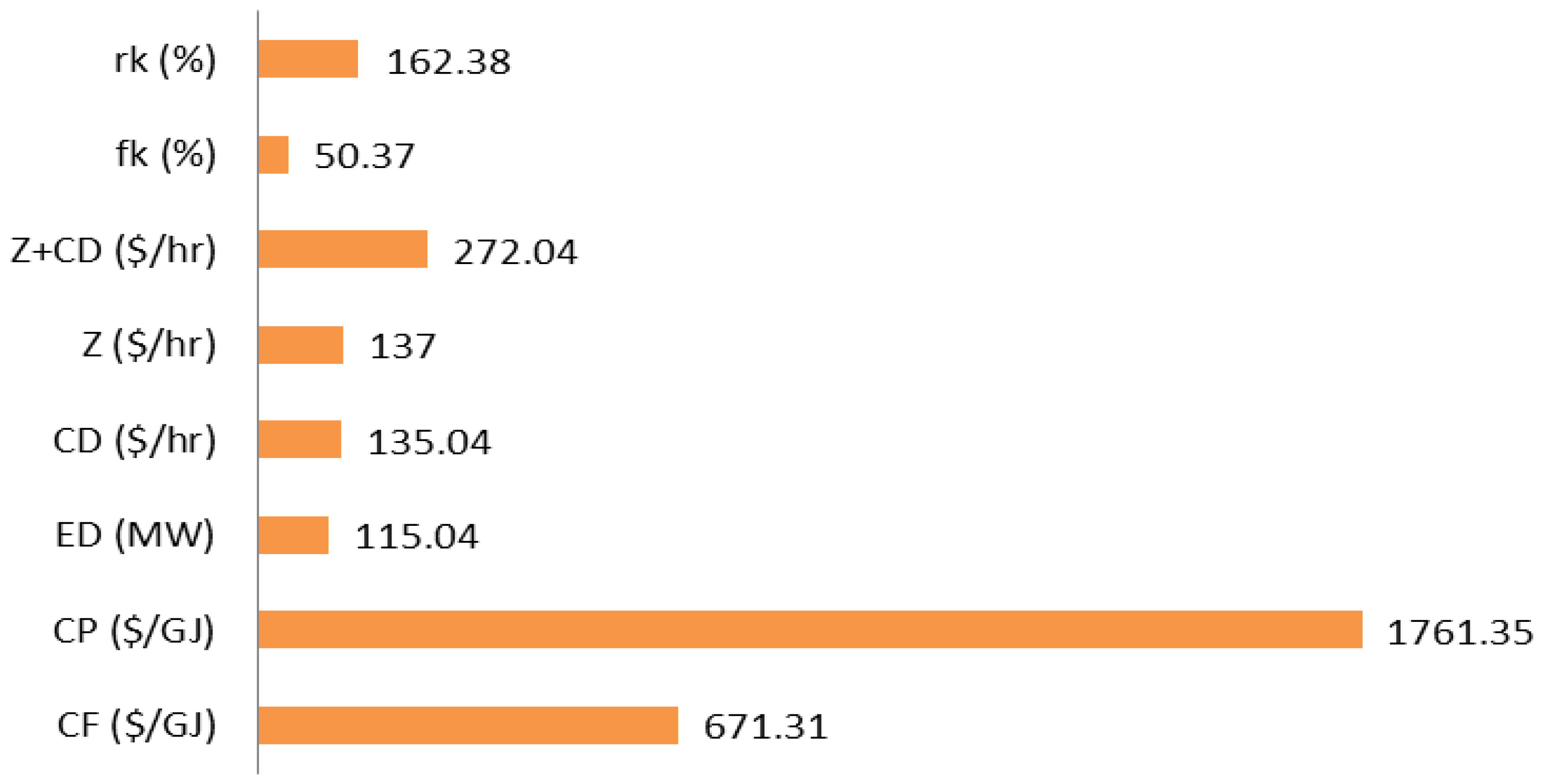
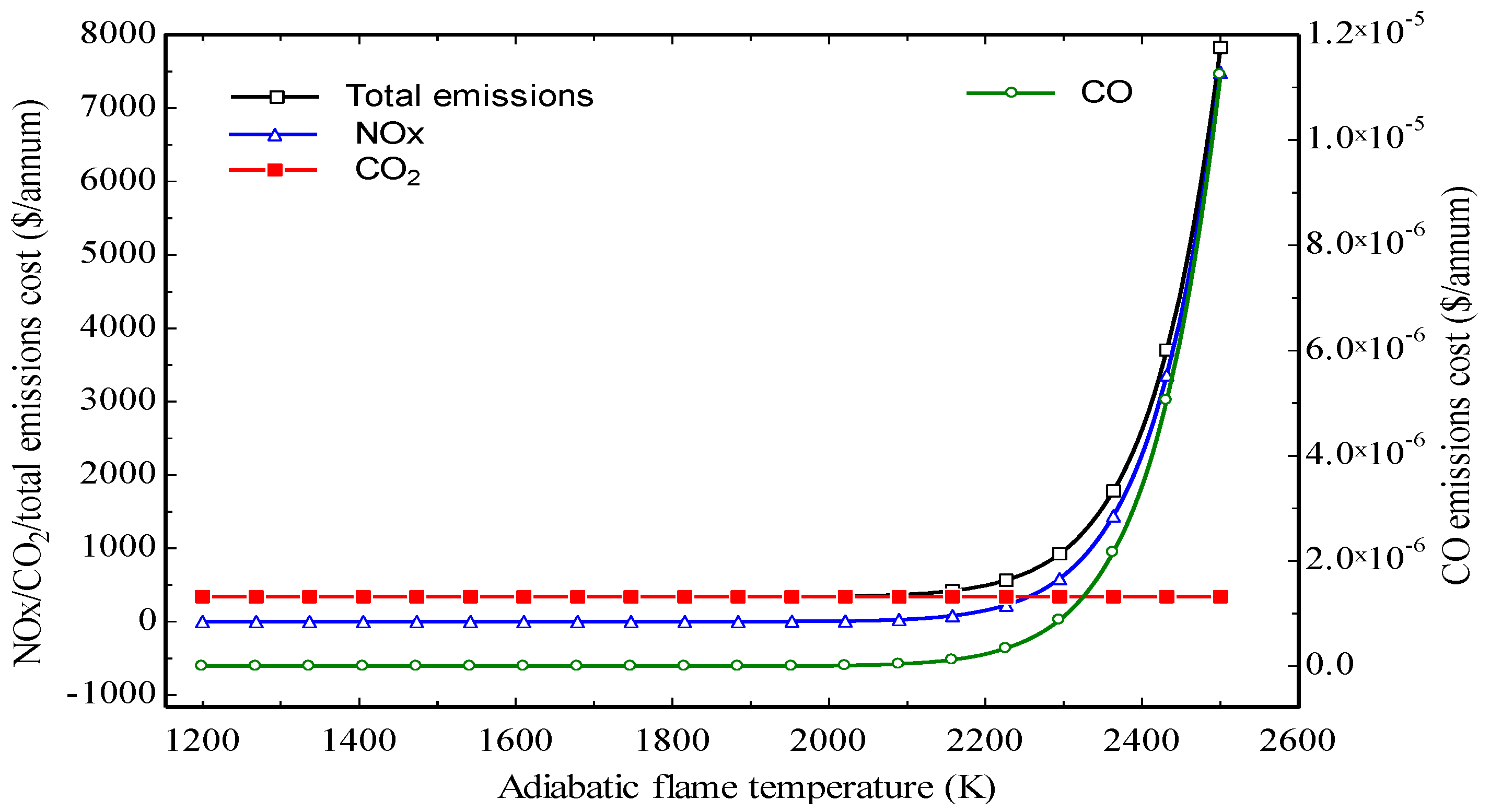
| Components | |
|---|---|
| Gasifier | |
| Air compressor | |
| GT | |
| HRSG | |
| Steam turbine | |
| Steam condenser | |
| Feedwater pump | |
| ORC evaporator | |
| ORC-turbine | |
| ORC-condenser | |
| ORC-pump | |
| VAB-condenser | |
| VAB-evaporation | |
| VAB-absorber | |
| VAB-throttle valve | |
| VAB solution pump |
| Parameter | Symbol | Unit | Value |
|---|---|---|---|
| Ambient temperature | °C | 25 | |
| Ambient Pressure | bar | 1.013 | |
| GT Lower compression ratio | - | 3.162 | |
| GT Higher compression ratio | - | 3.162 | |
| Overall pressure ratio | - | 10 | |
| GT Heat exchanger effectiveness | % | 75 | |
| Low-pressure turbine isentropic efficiency | % | 85 | |
| High-pressure turbine isentropic efficiency | % | 85 | |
| Low-pressure compressor isentropic efficiency | % | 80 | |
| High-pressure compressor isentropic efficiency | % | 80 | |
| mass of air to the topping cycle | kg/s | 418 | |
| mass of gas at the inlet to the first combustion chamber | kg/s | 3.131 | |
| mass of gas at the inlet to the supplemental firing combustor (reheater) | kg/s | 21.49 | |
| The high-pressure turbine inlet temperature | °K | 1350 | |
| The low-pressure turbine inlet temperature | °K | 1200 | |
| The exit temperature of intercooler water | °C | 85 | |
| pinch point temperature for HP evaporator | °C | 25 | |
| pinch point temperature for LP evaporator | °C | 25 | |
| HRSG higher pressure | bar | 25 | |
| HRSG lower pressure | bar | 10 | |
| Steam turbine isentropic efficiency | % | 85 | |
| ST inlet pressure | bar | 25 | |
| ST inlet temperature | °C | 350 | |
| ST bled pressure | bar | 0.05 | |
| ST condenser pressure | P15 | bar | 0.08 |
| ORC turbine inlet temperature | °C | 90 | |
| ORC turbine inlet pressure | bar | 16.7 | |
| ORC turbine back pressure | bar | 6.87 | |
| ORC evaporator temperature | °C | −2 | |
| Kalina turbine inlet temperature | °C | 180 | |
| Kalina turbine inlet pressure | bar | 20 | |
| Kalina turbine back pressure | bar | 7 | |
| Kalina evaporator temperature | °C | −5.49 | |
| VAS evaporator temperature | °C | 1.651 | |
| HRSG lower pressure | bar | 10 |
| Unit | Parameters | Units | Value |
|---|---|---|---|
| Gas turbine | Net power | MW | 148.73 |
| Thermal efficiency | % | 35.91 | |
| Exergy efficiency | % | 35.79 | |
| Steam turbine | Net power | MW | 35.08 |
| Thermal efficiency | % | 32.52 | |
| Exergy efficiency | % | 35.15 | |
| ORC-power cooling | Net power | MW | 42.82 |
| Thermal efficiency | % | 18.81 | |
| Exergy efficiency | % | 22.22 | |
| Cooling load | kW | 45.36 | |
| Kalina-power cooling | Net power | kW | 36.27 |
| Thermal efficiency | % | 16.96 | |
| Exergy efficiency | % | 20.43 | |
| Cooling load | kW | 36.27 | |
| Vapor absorption | Exergy of cooling | kW | 11.12 |
| COP | - | 0.472 | |
| Cooling load | kW | 130.5 | |
| Desorber heat | kW | 162.1 | |
| Integrated multigeneration plant (IMP) | Net power | MW | 183.91 |
| Thermal efficiency | % | 61.5 | |
| Exergy efficiency | % | 44.22 |
| Parameters | Symbol | Units | Value |
|---|---|---|---|
| emission rates | kg/s | 0.222 | |
| emission | kg/s | 3.0 × 10−7 | |
| Specific emission | 122.2 | ||
| Fuel emission harmful factor | - | 0.00066 | |
| Exergetic utility exponent | EUI | - | 0.7335 |
| Exergo-thermal index | ETI | - | 0.675 |
| Sustainability index | SI | - | 1.434 |
| S/N | Study | Reference | Energy Efficiency, % | Exergy Efficiency, % |
|---|---|---|---|---|
| 1 | Development and techno-economic assessment of a new biomass-assisted integrated plant for multi-generation | [44] | 63.62 | 59.26 |
| 2 | Development and analysis of a novel biomass-based integrated system for multi-generation with hydrogen production | [45] | 63.60 | 40.00 |
| 3 | Development and assessment of renewable energy–integrated multi-generation system for Rural Communities in Nigeria: Case Study. | [46] | 62.72 | 23.49 |
| 4 | Design and thermodynamic assessment of a biomass gasification plant integrated with Brayton cycle and solid oxide steam electrolyzer for compressed hydrogen production. | [47] | 52.84 | 46.49 |
| 5 | Thermo-enviroeconomic modeling of Integrated Multi-generation power plant with biomass syngas supplemental firing | present study | 61.50 | 44.22 |
| Component | ($/GJ) | ($/GJ) | (MW) | ($/hr.) | ($/hr.) | (%) | ($/hr.) | (%) | (%) |
|---|---|---|---|---|---|---|---|---|---|
| GT CC | 0.158 | 0.203 | 50.365 | 28.542 | 5.895 | 80.54 | 34.438 | 82.88 | 28.48 |
| GT HEX | 0.168 | 0.221 | 10.128 | 6.131 | 2.148 | 81.05 | 8.280 | 74.06 | 31.55 |
| GT HPC | 1.389 | 0.511 | 9.575 | 47.880 | 12.189 | 79.98 | 60.067 | 79.71 | 31.36 |
| GT HPT | 0.203 | 0.392 | 10.039 | 7.346 | 37.858 | 86.88 | 45.204 | 16.25 | 93.10 |
| GT INTC | 0.504 | 2.959 | 2.702 | 4.908 | 2.195 | 22.93 | 7.1023 | 69.10 | 487.10 |
| GT LPC | 0.339 | 0.504 | 2.883 | 3.513 | 12.189 | 90.12 | 15.703 | 22.38 | 48.67 |
| GT LPT | 0.169 | 0.353 | 8.871 | 5.372 | 41.693 | 88.92 | 47.064 | 11.42 | 108.88 |
| GT REH | 0.156 | 0.165 | 4.201 | 2.352 | 5.483 | 97.62 | 7.835 | 30.02 | 5.77 |
| Component | ($/GJ) | ($/GJ) | (MW) | ($/hr.) | ($/hr.) | (%) | ($/hr.) | (%) | (%) |
|---|---|---|---|---|---|---|---|---|---|
| HRSG HPE | 0.1681 | 0.495 | 0.297 | 0.1803 | 1.371 | 81.55 | 1.550 | 11.63 | 194.47 |
| HRSG HPEV | 0.1682 | 0.237 | 5.176 | 3.1334 | 1.195 | 77.23 | 4.329 | 72.38 | 40.90 |
| HRSG LPE | 0.1682 | 1.104 | 0.056 | 0.0342 | 1.167 | 86.32 | 1.201 | 2.85 | 556.36 |
| HRSG LPEV | 0.1681 | 0.489 | 5.432 | 3.2890 | 1.372 | 56.79 | 4.661 | 70.56 | 190.90 |
| HRSG PUM | 1.7352 | 17.752 | 0.022 | 0.1357 | 0.453 | 31.97 | 0.589 | 23.04 | 923.05 |
| Component | ($/GJ) | ($/GJ) | (MW) | ($/hr.) | ($/hr.) | (%) | ($/hr.) | (%) | (%) |
|---|---|---|---|---|---|---|---|---|---|
| KCN5 | 27.145 | 52.848 | 0.0011 | 0.1119 | 0.0343 | 57.99 | 0.1462 | 76.54 | 94.69 |
| KCN6 | 16.284 | 200.914 | 0.0687 | 4.0317 | 0.0805 | 8.255 | 4.1122 | 98.04 | 1133.81 |
| KEV 1 | 9.619 | 12.819 | 0.0066 | 0.2194 | 1.7229 | 96.38 | 1.9424 | 11.30 | 33.27 |
| KEV 2 | 26.533 | 1.0 × 10−6 | 0.0025 | 0.2390 | 0.4630 | 48.36 | 0.7020 | 34.04 | 100.00 |
| KHEX 2 | 66.534 | 13.191 | 0.0004 | 0.0867 | 0.2746 | 73.04 | 0.3614 | 23.99 | 80.17 |
| KHEX 3 | 27.148 | 145.76 | 0.0016 | 0.1611 | 0.1720 | 32.12 | 0.3332 | 48.36 | 436.91 |
| KPUM 1 | 23.540 | 34.121 | 0.0001 | 0.0001 | 0.0405 | 99.95 | 0.0406 | 0.25 | 44.95 |
| KSP 1 | 13.969 | 15.326 | 0.0098 | 0.4918 | 0.2986 | 94.31 | 0.7903 | 62.22 | 9.71 |
| KSP 2 | 15.321 | 16.286 | 0.0004 | 0.0236 | 0.2654 | 99.49 | 0.2889 | 8.17 | 6.30 |
| KTUB | 15.317 | 23.530 | 2.0 × 10−5 | 0.0000 | 1.1942 | 99.99 | 1.1942 | 2.0 × 10−6 | 53.62 |
| KVAL 1 | 15.324 | 26.238 | 0.0168 | 0.9301 | 0.0268 | 59.09 | 0.9569 | 97.20 | 71.22 |
| KVAL 2 | 16.286 | 32.012 | 0.0002 | 0.0152 | 0.0230 | 72.24 | 0.0382 | 39.79 | 96.56 |
| KALV 3 | 16.284 | 41.795 | 0.0043 | 0.2551 | 0.0212 | 40.88 | 0.2763 | 92.33 | 156.66 |
| Component | ($/GJ) | ($/GJ) | (MW) | ($/hr.) | ($/hr.) | (%) | ($/hr.) | (%) | (%) |
|---|---|---|---|---|---|---|---|---|---|
| ORC CON 2 | 20.664 | 114.089 | 2.5300 | 0.2166 | 0.016 | 18.70 | 0.232 | 93.017 | 452.11 |
| ORC CON 3 | 10.755 | 81.846 | 0.0607 | 2.3527 | 0.066 | 13.46 | 2.418 | 97.261 | 661.00 |
| ORC EVP 4 | 20.233 | 52.307 | 0.0755 | 5.5059 | 0.565 | 41.03 | 6.071 | 90.690 | 158.52 |
| ORC EVP 5 | 16.559 | 3.0 × 10−6 | 0.0032 | 0.1917 | 0.269 | 28.84 | 0.461 | 41.579 | 100.00 |
| ORC HEX 5 | 27.494 | 20.670 | 0.0004 | 0.0416 | 0.158 | 91.90 | 0.200 | 20.780 | 24.82 |
| ORC PUM 4 | 27.551 | 50.028 | 2.0 × 10−7 | 0.0000 | 0.073 | 71.69 | 0.073 | 2.0 × 10−7 | 81.58 |
| ORC TUB | 20.673 | 27.563 | 2.0 × 10−6 | 0.0000 | 1.366 | 99.99 | 1.366 | 3.0 × 10−6 | 33.33 |
| ORC VAL 6 | 20.663 | 24.918 | 0.0031 | 0.2290 | 0.005 | 83.30 | 0.234 | 97.687 | 20.59 |
| Component | ($/GJ) | ($/GJ) | (MW) | ($/hr.) | ($/hr.) | (%) | ($/hr.) | (%) | (%) |
|---|---|---|---|---|---|---|---|---|---|
| ST CON | 0.3801 | 0.317 | 0.8655 | 1.1846 | 1.721 | 60.07 | 2.905 | 40.77 | 16.60 |
| ST FWH 1 | 0.3306 | 0.847 | 0.1093 | 0.1301 | 0.430 | 47.58 | 0.560 | 23.22 | 156.20 |
| ST FWH 2 | 0.5711 | 0.699 | 1.4910 | 3.0655 | 0.573 | 94.06 | 3.639 | 84.23 | 22.40 |
| ST PUM 1 | 1.7352 | 10.43 | 1.0 × 10−7 | 1.0 × 10−5 | 0.065 | 99.99 | 0.065 | 1.0 × 10−6 | 501.08 |
| ST PUM 2 | 1.7345 | 7.977 | 1.0 × 10−7 | 1.0 × 10−5 | 0.147 | 99.99 | 0.147 | 1.0 × 10−6 | 359.90 |
| ST PUM 3 | 1.7341 | 7.177 | 1.0 × 10−7 | 1.0 × 10−5 | 0.205 | 99.99 | 0.205 | 1.0 × 10−6 | 313.87 |
| ST TUB | 0.3178 | 1.734 | 1.0 × 10−6 | 2.0 × 10−4 | 0.817 | 99.99 | 0.817 | 1.0 × 10−5 | 445.63 |
| Component | ($/GJ) | ($/GJ) | (MW) | ($/hr.) | ($/hr.) | (%) | ($/hr.) | (%) | (%) |
|---|---|---|---|---|---|---|---|---|---|
| VABA | 13.200 | 57.132 | 0.0080 | 0.3790 | 0.0999 | 26.37 | 0.4789 | 79.14 | 332.82 |
| VAB CON 4 | 68.982 | 217.240 | 0.0047 | 1.162 | 0.0290 | 32.29 | 1.1905 | 97.56 | 214.92 |
| VABDE | 13.200 | 57.132 | 0.0163 | 0.776 | 0.1499 | 26.37 | 0.9259 | 83.81 | 332.82 |
| VAB EVP 3 | 4.657 | 1.0 × 10−5 | 0.0076 | 0.127 | 0.1861 | 31.51 | 0.3135 | 40.64 | 100.00 |
| VAB HEX 4 | 58.580 | 102.335 | 0.0003 | 0.066 | 0.2117 | 84.94 | 0.2777 | 23.77 | 74.69 |
| VAB PUM 7 | 23.527 | 150.988 | 2.0 × 10−6 | 0.0002 | 0.0008 | 100.00 | 0.0009 | 20.41 | 541.76 |
| VAB VAL 4 | 9.577 | 66.704 | 0.0058 | 0.201 | 0.0058 | 13.89 | 0.2071 | 97.20 | 596.50 |
| VAB VAL 5 | 13.380 | 68.978 | 0.0007 | 0.031 | 0.0073 | 14.30 | 0.0388 | 81.29 | 415.53 |
| Parameter | Symbol | Units | Value |
|---|---|---|---|
| Cost of IMP equipment | 9.43 | ||
| Life cycle cost (LCC) | 1.575 | ||
| Daily energy production | 4413.84 | ||
| Annual energy production | |||
| The unit cost of energy | $/kW | 0.0166 | |
| Annualized life cycle cost | 2.6748 | ||
| Break-even point | year | 4.0 |
| Performance Index | Optimization Function | Decision Variables | Optimization Constraints |
|---|---|---|---|
| , 8 , | |||
| , 8 , | |||
| , pressure at , , pressure at , , pressure at , , pressure at , | , 2740, , 2130 | ||
| pressure at , | |||
| , | , | ||
| , −3 and −1.5 °C | |||
| , −5.8 and −1.5 °C | |||
| All listed parameters |
Publisher’s Note: MDPI stays neutral with regard to jurisdictional claims in published maps and institutional affiliations. |
© 2020 by the authors. Licensee MDPI, Basel, Switzerland. This article is an open access article distributed under the terms and conditions of the Creative Commons Attribution (CC BY) license (http://creativecommons.org/licenses/by/4.0/).
Share and Cite
Abam, F.I.; Diemuodeke, O.E.; Ekwe, E.B.; Alghassab, M.; Samuel, O.D.; Khan, Z.A.; Imran, M.; Farooq, M. Exergoeconomic and Environmental Modeling of Integrated Polygeneration Power Plant with Biomass-Based Syngas Supplemental Firing. Energies 2020, 13, 6018. https://doi.org/10.3390/en13226018
Abam FI, Diemuodeke OE, Ekwe EB, Alghassab M, Samuel OD, Khan ZA, Imran M, Farooq M. Exergoeconomic and Environmental Modeling of Integrated Polygeneration Power Plant with Biomass-Based Syngas Supplemental Firing. Energies. 2020; 13(22):6018. https://doi.org/10.3390/en13226018
Chicago/Turabian StyleAbam, Fidelis. I., Ogheneruona E. Diemuodeke, Ekwe. B. Ekwe, Mohammed Alghassab, Olusegun D. Samuel, Zafar A. Khan, Muhammad Imran, and Muhammad Farooq. 2020. "Exergoeconomic and Environmental Modeling of Integrated Polygeneration Power Plant with Biomass-Based Syngas Supplemental Firing" Energies 13, no. 22: 6018. https://doi.org/10.3390/en13226018
APA StyleAbam, F. I., Diemuodeke, O. E., Ekwe, E. B., Alghassab, M., Samuel, O. D., Khan, Z. A., Imran, M., & Farooq, M. (2020). Exergoeconomic and Environmental Modeling of Integrated Polygeneration Power Plant with Biomass-Based Syngas Supplemental Firing. Energies, 13(22), 6018. https://doi.org/10.3390/en13226018










